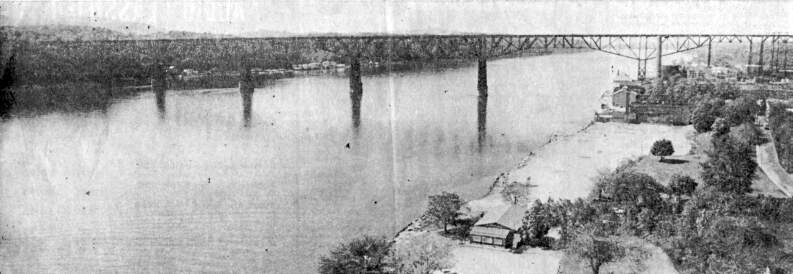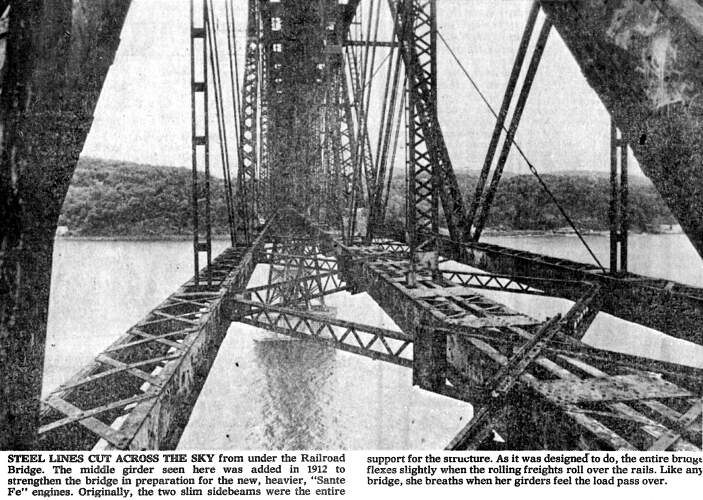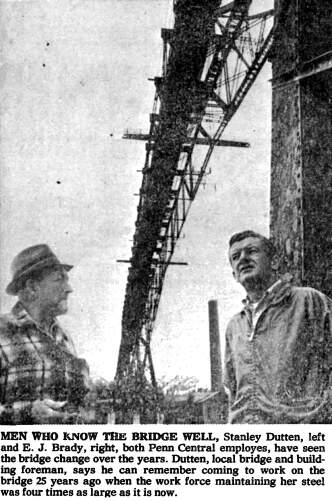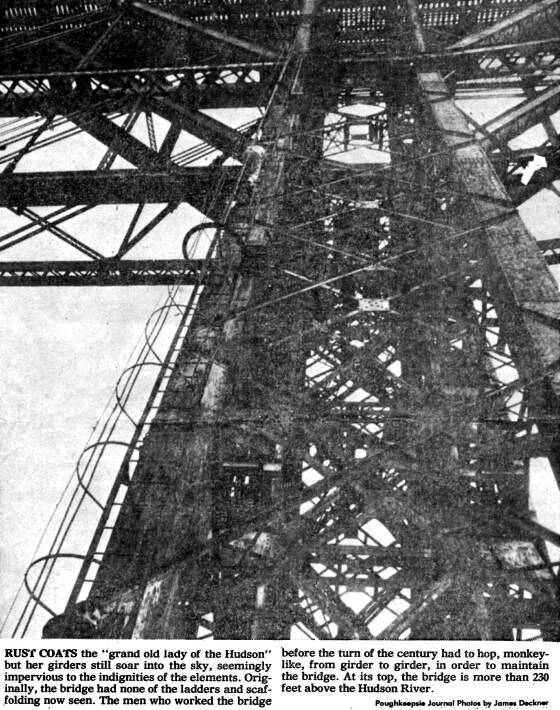|
Poughkeepsie Journal—Sunday, July 2, 1972
'The Lady' Has Aged

A memorial to forgotten dreams; the Poughkeepsie Railroad Bridge
stands, stark against the sky 86 years after the first engine
crossed its trusses.
Called by its boosters in the late 19th century Poughkeepsie's
"great hope," it is still used by the railroad daily
but has never lived up to its promise of bringing Poughkeepsie's
population to the 50,000 mark.
So now it stands, its black form looking more and more like
a forgotten plaything.
It was once the darling of the town, once its greatest pride.
Now, when one hears a city resident speak of the bridge it
is in terms of "how long can it last?"
The architect of the George Washington Bridge is reputed to
have said, "With minimal care, by that I mean painting, that
bridge should last forever."
The Railroad Bridge will probably not last forever, but its
long history does suggest that there is "life in the old
girl yet."
When completed in 1889, the bridge had taken over 20 years
to construct.
Its building was not an easy process.
But Poughkeepsie knew that if it were to tap the great rail
networks that were snaking their way across the landscape it would
have to provide not only north-south rail service but east-west
as well.
The idea of the bridge received its first impetus in the editorial
column of one of the Journal's predecessors, and soon the business
community had sponsored a company to build the great span.
The design chosen for the bridge was what is called an unequal
length cantilever.
This means that the trusses of the bridge, the supports branching
off the piers, are of unequal length, in this case ranging from
525 to 548 feet in length.
This was supposed to allow for greater stresses at different
points of the bridge.
Being a cantilever bridge and using trusses and girders, the
weight of the bridge and its passing load is transferred through
the structure to the supporting piers.
Because of its design, the bridge is not rigid but is basically
a counter-stressed hinged structure.
Thus when one stands under the bridge, one can feel the passing
of a train. The structure flexes under the load much like a living
creature.
However, in 1912 when the rail-roads began using what were
called the "Santa Fe" type engines, heavier than previous
models, the bridge had to be strengthened and made more rigid.
It was then that the middle girder in the bridge was added.
Originally, the two side girders that stretch the length of
the bridge carried the principal load.

Now the third, middle, girder shares it with them, making the
bridge much more solid.
Despite the third girder, the hoped for traffic between the
coal fields of the west and the markets of the east never materialized.
In fact, the bridge never fulfilled its promise and was sold,
along with its rather small railroad, to the New Haven Railroad
in the early part of this century.
The Penn Central then received the bridge as part of its merger,
when it was forced to acquire the New York, New Haven and Hartford
Railroad.
Now the bridge's girders support but a fraction of the traffic
they were meant to bear and its black countenence speaks almost
of mourning for its neglected status.
 The Journal was inside those
girders recently to take a closer look at its condition and found
that the Penn The Journal was inside those
girders recently to take a closer look at its condition and found
that the Penn
Central has, in spite of financial difficulties, made substantial
efforts to maintain the bridge.
The. tour was conducted by E J Brady, New Haven Division bridge
And building supervisor, and Stanley Dutten, general bridge and
building foreman for the Railroad Bridge.
Starting at the Highland side of the bridge and walking over
the entire span to Poughkeepsie, we had a first hand chance to
see what condition the bridge is in.
On the Highland side to about the middle of the bridge there
is evidence of a fairly recent paint job.
This painting covers up much of the aluminum paint that went
on in the mid-50s. It turned out that the aluminum paint would
not adhere to the old steel and simply washed off.
The new paint was applied four years ago, but the job was stopped
for lack of funds.
Some painting has started from the Poughkeepsie end of the
bridge, but the largest section of the bridge has not seen new
paint in many years.
In spite of this, the bridge looks tremendously strong from
its interior.
We I climbed down the entire length of one of the piers, over
230 feet, to inspect the lower beams.
The ladders that stretch from the heights of the bridge to
its piers were installed to ease the task of inspectors who look
over the condition of the bridge several times a year.
Straight down massive rusty girders, descending into the bowels
of the bridge, one cannot help but think that this, much steel
cannot give way.
The bridge may show its years but the grand old lady of the
Hudson can still carry her load from all we could see.
Still, traffic over the Hudson is not what it used to be, and
the day can be envisioned when the bankrupt railroad is going
to decide that the traffic over the bridge doesn't pay for its
maintenance and the old lady will be shorn, stripped, and removed
from our sight.
The bridge … it was meant to give this city life, but
the perils of national commerce have removed that hope.

Poughkeepsie Bridge | Bridge
Page | Contents Page
|







